The Checking visitor is an unwanted web-page which pops up on system that’s infected with adware (also known as ‘ad-supported’ software). The ad-supported software is one of the most annoying type of malicious software floating around the Net: an attack generates a ton of intrusive popups within a user internet browser’s screen. A lot of people have fallen victim to these kinds of attacks, looking the Internet in hopes of finding few simple steps on how to remove annoying pop ups. Now, computer geeks and Myantispyware lab have teamed up to create the step-by-step guide that help users get rid of Checking visitor redirect for free.
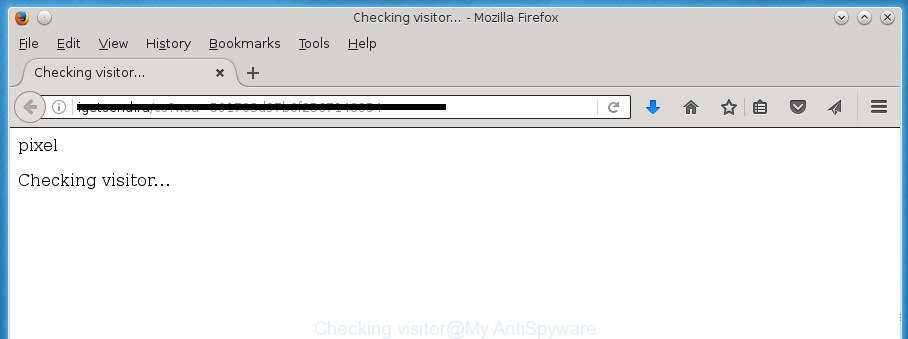
“Checking visitor…” pop-up
The ad-supported software may insert a huge number of popup directly to the web-sites that you visit, creating a sense that the advertising links has been added by the creators of the web-site. Moreover, a legal advertising banners may be replaced on the fake popups, that will offer to download and install various unnecessary and harmful programs. Moreover, the ‘ad supported’ software has the ability to collect a huge number of personal information about you (your ip address, what is a web page you are viewing now, what you are looking for on the Web, which links you are clicking), which can later transfer to third parties.
Table of contents
- What is Checking visitor
- Checking visitor redirect removal steps
- Manual Checking visitor pop ups removal
- Remove adware and other potentially unwanted programs through the Windows Control Panel
- Disinfect the web browser’s shortcuts to get rid of Checking visitor redirect
- Get rid of Checking visitor from Firefox by resetting internet browser settings
- Remove Checking visitor pop-up from Microsoft Internet Explorer
- Remove Checking visitor pop-ups from Google Chrome
- Get rid of unwanted Scheduled Tasks
- How to remove Checking visitor pop-up with freeware
- Manual Checking visitor pop ups removal
- Stop Checking visitor popups and other intrusive web-pages
- Tips to prevent Checking visitor pop ups and other unwanted applications
- Final words
The ad supported software often change all browser shortcuts that located on your Desktop to force you visit various unwanted ad pages. As a result, your web browser can still redirect you to an undesired ad web-page despite your system is actually free of ‘ad supported’ software and other malware.
So, obviously, you need to remove the adware as soon as possible. Use the free step-by-step instructions below. This guide will help you clean your PC system of ‘ad supported’ software and thereby get rid of the Checking visitor undesired pop up.
Checking visitor redirect removal steps
We can assist you remove Checking visitor from your browsers, without the need to take your system to a professional. Simply follow the removal instructions below if you currently have the unwanted adware on your system and want to delete it. If you have any difficulty while trying to remove the ad-supported software that causes intrusive Checking visitor pop-ups, feel free to ask for our assist in the comment section below. Read this manual carefully, bookmark or print it, because you may need to close your web-browser or restart your PC system.
Manual Checking visitor pop ups removal
The following instructions is a step-by-step guide, which will help you manually delete Checking visitor popups from the Chrome, Firefox, Microsoft Edge and Microsoft Internet Explorer.
Remove adware and other potentially unwanted programs through the Windows Control Panel
First, go to MS Windows Control Panel and remove suspicious software, all programs you do not remember installing. It’s important to pay the most attention to applications you installed just before Checking visitor popup appeared on your browser. If you don’t know what a program does, look for the answer on the Internet.
Windows 10, 8.1, 8
Click the Microsoft Windows logo, and then press Search ![]() . Type ‘Control panel’and press Enter as shown on the screen below.
. Type ‘Control panel’and press Enter as shown on the screen below.

After the ‘Control Panel’ opens, click the ‘Uninstall a program’ link under Programs category as on the image below.

Windows 7, Vista, XP
Open Start menu and select the ‘Control Panel’ at right as shown below.

Then go to ‘Add/Remove Programs’ or ‘Uninstall a program’ (Windows 7 or Vista) like below.

Carefully browse through the list of installed applications and delete all applications which has the name similar to the Checking visitor web-site. We recommend to click ‘Installed programs’ and even sorts all installed programs by date. When you have found anything suspicious that may be the hijacker, adware or PUPs, then select this application and press ‘Uninstall’ in the upper part of the window. If the suspicious application blocked from removal, then use Revo Uninstaller Freeware to fully delete it from your computer.
Disinfect the web browser’s shortcuts to get rid of Checking visitor redirect
After installed, this ad supported software may add an argument such as “http://site.address” into the Target property of the desktop shortcut for the FF, Google Chrome, Internet Explorer and Microsoft Edge. Due to this, every time you start the internet browser, it will show an intrusive ad page.
Right click to a desktop shortcut for your internet browser. Choose the “Properties” option. It will open the Properties window. Select the “Shortcut” tab here, after that, look at the “Target” field. The adware can replace it. If you are seeing something similar “…exe http://site.address” then you need to remove “http…” and leave only, depending on the browser you are using:
- Google Chrome: chrome.exe
- Opera: opera.exe
- Firefox: firefox.exe
- Internet Explorer: iexplore.exe
Look at the example as shown on the screen below.

Once is finished, click the “OK” button to save the changes. Please repeat this step for browser shortcuts which redirects to an undesired web sites. When you have completed, go to next step.
Get rid of Checking visitor from Firefox by resetting internet browser settings
Resetting your Firefox is good initial troubleshooting step for any issues with your browser program, including the redirect to Checking visitor web page.
First, launch the FF and click ![]() button. It will display the drop-down menu on the right-part of the web-browser. Further, press the Help button (
button. It will display the drop-down menu on the right-part of the web-browser. Further, press the Help button (![]() ) like below
) like below
.

In the Help menu, select the “Troubleshooting Information” option. Another way to open the “Troubleshooting Information” screen – type “about:support” in the browser adress bar and press Enter. It will open the “Troubleshooting Information” page as on the image below. In the upper-right corner of this screen, click the “Refresh Firefox” button.

It will open the confirmation dialog box. Further, click the “Refresh Firefox” button. The Mozilla Firefox will begin a task to fix your problems that caused by the ‘ad supported’ software which causes intrusive Checking visitor pop up. When, it’s finished, press the “Finish” button.
Remove Checking visitor pop-up from Microsoft Internet Explorer
The Internet Explorer reset is great if your internet browser is hijacked or you have unwanted addo-ons or toolbars on your internet browser, which installed by an malicious software.
First, start the IE, then click ‘gear’ icon ![]() . It will display the Tools drop-down menu on the right part of the web browser, then click the “Internet Options” as shown on the image below.
. It will display the Tools drop-down menu on the right part of the web browser, then click the “Internet Options” as shown on the image below.

In the “Internet Options” screen, select the “Advanced” tab, then click the “Reset” button. The IE will display the “Reset Internet Explorer settings” dialog box. Further, click the “Delete personal settings” check box to select it. Next, click the “Reset” button as shown in the figure below.

Once the process is done, click “Close” button. Close the Internet Explorer and reboot your PC system for the changes to take effect. This step will help you to restore your web-browser’s home page, new tab page and default search provider to default state.
Remove Checking visitor pop-ups from Google Chrome
If your Chrome web browser is re-directed to annoying Checking visitor web page, it may be necessary to completely reset your browser program to its default settings.
Open the Chrome menu by clicking on the button in the form of three horizontal stripes (![]() ). It will show the drop-down menu. Next, press to “Settings” option.
). It will show the drop-down menu. Next, press to “Settings” option.

Scroll down to the bottom of the page and click on the “Show advanced settings” link. Now scroll down until the Reset settings section is visible, as shown in the figure below and press the “Reset settings” button.
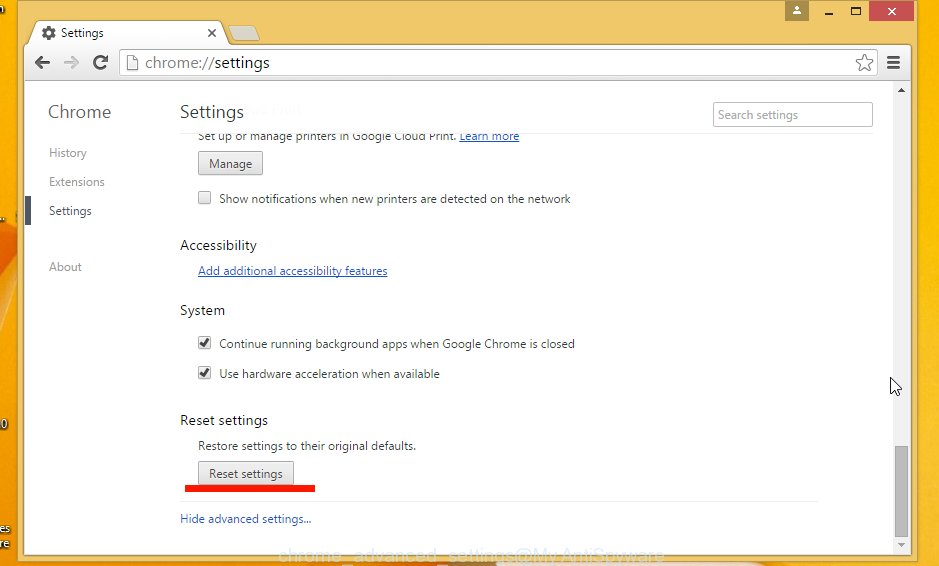
Confirm your action, press the “Reset” button.
Get rid of unwanted Scheduled Tasks
If the unwanted Checking visitor page opens automatically on Windows startup or at equal time intervals, then you need to check the Task Scheduler Library and remove all the tasks that have been created by malicious application.
Press Windows and R keys on your keyboard simultaneously. It will display a prompt that titled as Run. In the text field, type “taskschd.msc” (without the quotes) and click OK. Task Scheduler window opens. In the left-hand side, click “Task Scheduler Library”, as shown below.
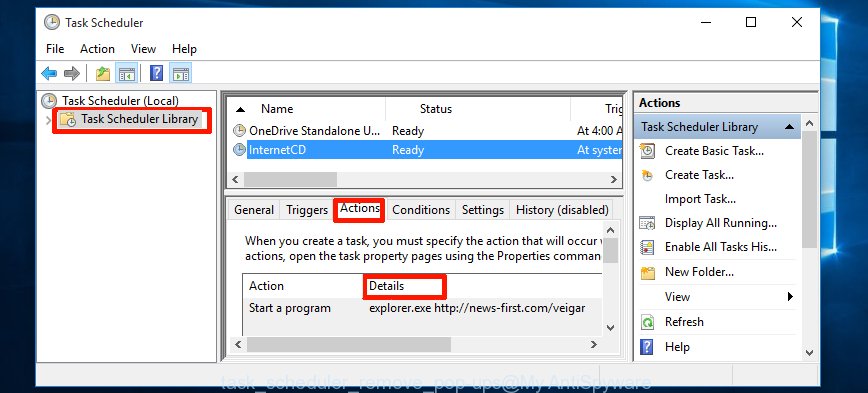
Task scheduler, list of tasks
In the middle part you will see a list of installed tasks. Select the first task, its properties will be display just below automatically. Next, click the Actions tab. Necessary to look at the text which is written under Details. Found something such as “explorer.exe http://site.address” or “chrome.exe http://site.address” or “firefox.exe http://site.address”, then you need remove this task. If you are not sure that executes the task, then google it. If it’s a component of the adware, then this task also should be removed.
Further click on it with the right mouse button and select Delete as shown below.

Task scheduler, delete a task
Repeat this step, if you have found a few tasks that have been created by malicious program. Once is done, close the Task Scheduler window.
How to remove Checking visitor pop-up with freeware
The easiest way to get rid of Checking visitor redirect is to use an anti malware program capable of detecting this adware that causes browsers to display annoying Checking visitor popups. We suggest try Zemana Anti-malware or another free malware remover which listed below. It has excellent detection rate when it comes to ad supported software, hijackers and other potentially unwanted programs.
Automatically delete Checking visitor redirect with Zemana Anti-malware
We suggest using the Zemana Anti-malware. You can download and install Zemana Anti-malware to find ad supported software and thereby get rid of Checking visitor redirect from the Firefox, Chrome, Microsoft Internet Explorer and Edge web-browsers. When installed and updated, the malicious software remover will automatically check and detect all threats present on your machine.
Now you can install and run Zemana AntiMalware to get rid of Checking visitor pop-up from your browser by following the steps below:
Click the link below to download Zemana Anti-Malware installer called Zemana.AntiMalware.Setup on your computer.
164813 downloads
Author: Zemana Ltd
Category: Security tools
Update: July 16, 2019
Launch the setup file after it has been downloaded successfully and then follow the prompts to install this tool on your computer.

During installation you can change some settings, but we suggest you don’t make any changes to default settings.
When installation is done, this malware removal utility will automatically start and update itself. You will see its main window like below.

Now press the “Scan” button to perform a system scan for the adware which cause unwanted Checking visitor pop ups to appear. A system scan can take anywhere from 5 to 30 minutes, depending on your PC. While the utility is scanning, you can see how many objects and files has already scanned.

After that process is finished, you will be opened the list of all detected items on your computer. All found items will be marked. You can get rid of them all by simply click “Next” button.

The Zemana Anti-Malware will get rid of adware that causes a large amount of annoying Checking visitor pop up. When disinfection is complete, you can be prompted to restart your PC to make the change take effect.
Automatically remove Checking visitor redirect with Malwarebytes
We suggest using the Malwarebytes Free that are completely clean your personal computer of the adware. The free utility is an advanced malware removal program developed by (c) Malwarebytes lab. This application uses the world’s most popular antimalware technology. It is able to help you delete intrusive Checking visitor pop-ups from your web browsers, potentially unwanted programs, malicious software, browser hijackers, toolbars, ransomware and other security threats from your system for free.
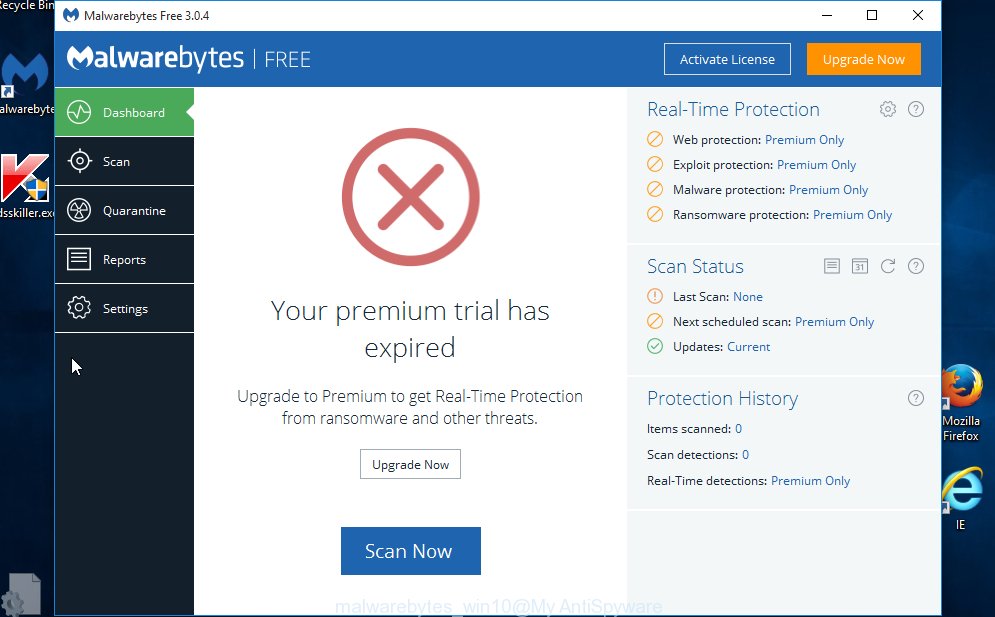
- Download Malwarebytes (MBAM) by clicking on the link below.
Malwarebytes Anti-malware
327070 downloads
Author: Malwarebytes
Category: Security tools
Update: April 15, 2020
- When the download is done, close all applications and windows on your computer. Open a file location. Double-click on the icon that’s named mb3-setup.
- Further, press Next button and follow the prompts.
- Once install is finished, click the “Scan Now” button to perform a system scan for the adware that causes unwanted Checking visitor popup. This procedure can take quite a while, so please be patient. While the program is checking, you can see number of objects it has identified as threat.
- When it completes the scan, it will open a screen that contains a list of malicious software that has been detected. Review the results once the tool has done the system scan. If you think an entry should not be quarantined, then uncheck it. Otherwise, simply press “Quarantine Selected”. After disinfection is done, you can be prompted to reboot your personal computer.
The following video offers a step by step guidance on how to get rid of hijackers, adware and other malware with Malwarebytes.
If the problem with Checking visitor redirect is still remained
If MalwareBytes anti malware or Zemana anti malware cannot remove this ad-supported software, then we recommends to run the AdwCleaner. AdwCleaner is a free removal tool for hijackers, PUPs, toolbars and ‘ad supported’ software that causes web browsers to open unwanted Checking visitor popups.
Download AdwCleaner from the link below.
225545 downloads
Version: 8.4.1
Author: Xplode, MalwareBytes
Category: Security tools
Update: October 5, 2024
Once the downloading process is done, open the file location. You will see an icon like below.
![]()
Double click the AdwCleaner desktop icon. When the utility is launched, you will see a screen as shown in the figure below.
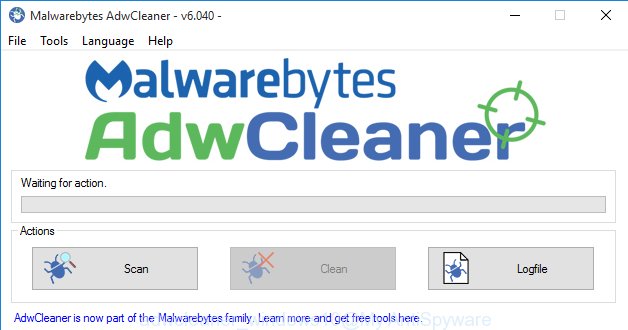
Further, click “Scan” button to perform a system scan with this tool for the adware which cause unwanted Checking visitor pop up to appear. This task can take quite a while, so please be patient. When the scan is finished, the results are displayed in the scan report like below.
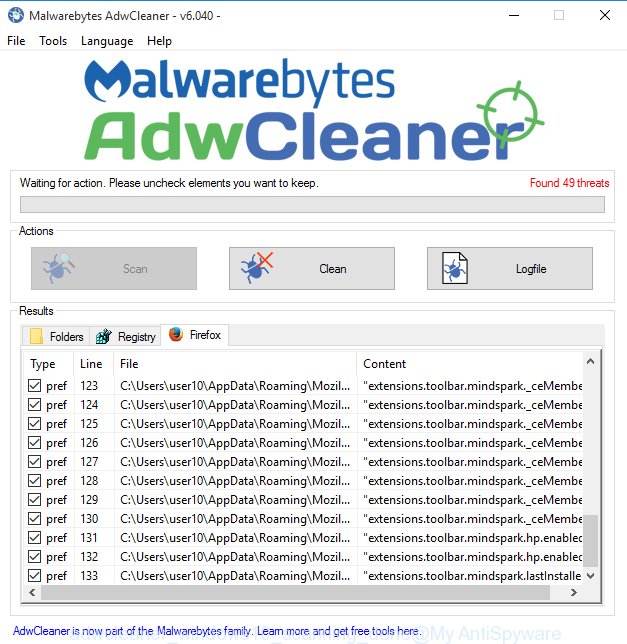
When you’re ready, click “Clean” button. It will display a prompt as shown on the image below.

You need to press “OK”. Once that process is finished, the AdwCleaner may ask you to restart your computer. When your system is started, you will see an AdwCleaner log.
These steps are shown in detail in the following video guide.
Stop Checking visitor popups and other intrusive web-pages
If you surf the Internet, you cannot avoid malicious advertising. But you can protect your browser against it. Download and use an ad blocker program. AdGuard is an ad blocker that can filter out a ton of of the malicious advertising, stoping dynamic scripts from loading harmful content.
Installing the AdGuard ad-blocker program is simple. First you will need to download AdGuard from the following link.
26842 downloads
Version: 6.4
Author: © Adguard
Category: Security tools
Update: November 15, 2018
Once the download is complete, double-click the downloaded file to launch it. The “Setup Wizard” window will show up on the computer screen as shown in the figure below.

Follow the prompts. AdGuard will then be installed and an icon will be placed on your desktop. A window will show up asking you to confirm that you want to see a quick instructions as on the image below.

Press “Skip” button to close the window and use the default settings, or click “Get Started” to see an quick tutorial which will allow you get to know AdGuard better.
Each time, when you start your computer, AdGuard will start automatically and stop pop-up, Checking visitor redirects, as well as other malicious or misleading web-pages. For an overview of all the features of the program, or to change its settings you can simply double-click on the AdGuard icon, that is located on your desktop.
Tips to prevent Checking visitor pop ups and other unwanted applications
Most often, the ad supported software come as a part of the setup packages from a free hosting and file sharing sites. So, install a freeware is a a good chance that you will find a bundled ad-supported software. If you don’t know how to avoid it, then use a simple trick. During the installation, choose the Custom or Advanced installation option. Next, click ‘Decline’ button and clear all checkboxes on offers that ask you to install third-party applications. Moreover, please carefully read Term of use and User agreement before installing any programs or otherwise you can end up with another unwanted program on your PC such as this ad supported software that causes a large count of unwanted Checking visitor pop ups.
Final words
Now your PC system should be free of the ad supported software which causes undesired Checking visitor pop up. Remove AdwCleaner. We suggest that you keep AdGuard (to help you stop unwanted pop ups and undesired harmful sites) and Zemana Anti-malware (to periodically scan your computer for new browser hijacker infections, malicious software and adware). Probably you are running an older version of Java or Adobe Flash Player. This can be a security risk, so download and install the latest version right now.
If you are still having problems while trying to delete Checking visitor redirect from the Firefox, Chrome, Internet Explorer and Microsoft Edge, then ask for help in our Spyware/Malware removal forum.


















